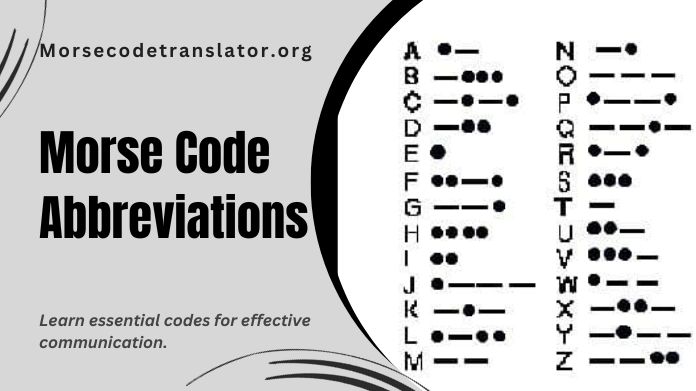In the intricate world of Morse Code, where dots and dashes weave a silent language, Morse Code abbreviations, prosigns, and wire signals add depth and efficiency.
As a method of telecommunication that predates the digital age, Morse Code is enriched with nuances that go beyond individual letters.
Join us on a journey through the Morse Code Translator guide as we unravel the Morse Code abbreviations that streamline messages, the prosigns that convey specialized meanings, and the wire signals that echo through the history of communication.
This exploration delves into the Morse Code abbreviations, where every signal is a symphony of brevity, precision, and historical significance.
Morse Code Abbreviations

In the Morse Code lexicon, abbreviations serve as linguistic shortcuts, compressing information without compromising clarity. These condensed signals find application across diverse fields, from military and aviation to radio communication.
Morse Code abbreviations encompass everything from standard procedural indicators to essential navigational instructions. As we delve deeper into this cryptic language, we unveil a mosaic of abbreviations that transcend dots and dashes, forming a tapestry of efficient communication.
Explore the Morse Code’s abbreviated universe with us, where brevity is not just a convenience but a fundamental aspect of a language that has withstood the test of time.
Note that some of these abbreviations have multiple meanings.
AA – “After all”
AB – “All before”
ABT – “About”
ADEE – “Addressee”
ADR – “Address”
ADS – “Address”
AGN – “Again”
AM – “Amplitude Modulation”
ANT – “Antenna”
BCI – “Broadcast Interference”
BCL – “Broadcast Listener”
BCNU – “Be seeing you”
BK – “Break” or “Break-in”
BN – “All between” or “Been”
BT – “Separation or add a space”
BTR – “Better”
BUG – “Semi-Automatic key”
B4 – “Before”
C – “Yes” or “Correct”
CFM – “Confirm” or “I confirm”
CK – “Check”
CKT – “Circuit”
CL – “I am closing my station” or “Call”
CLD – “Called”
CLG – “Calling”
CNT – “Can’t”
CONDX – “Conditions”
CQ – “Calling any station”
CU – “See you”
CUL – “See you later”
CUM – “Come”
CW – “Continuous-wave”
DA – Day – “Day”
DE – “From” or “This is”
DIFF – “Difference”
DLD – “Delivered”
DLVD – “Delivered”
DN – “Down”
DR – “Dear”
DX – “Distance”
EL – “Element”
ES – “Fine business” or “Excellent”
FER – “For”
FM -“From”
GA -“Go ahead” or “Good afternoon”
GB -“Goodbye” or “God bless”
GD -“Good”
GE -“Good Evening”
GESS -“Guess”
GG -“Going”
GM -“Good morning”
GN -“Good night”
GND -“Ground”
GUD -“Good”
GV -“Give”
GVG -“Giving”
HH -“Error in sending”
HI -“The telegraph laugh”
HPE -“Hope”
HQ -“Headquarters”
HR -“Here” or “Hear”
HV -“Have”
HW -“How” or “How copy?”
IMI -“Repeat” or “Say again”
INFO -“Info”
LID -“A poor operator”
LNG -“Long”
LTR -“Later” or “letter”
LV -“Leave”
LVG -“Leaving”
MA -“Milliamperes”
MILL -“Typewriter”
MILS -“Milliamperes”
MSG -Prefix to message
N -“No”, “Negative”, “Incorrect” or “No More”
NCS -“Net Control Station”
NIL -“Nothing” or “I have nothing for you”
NM -“No more”
NR -“Number”
NW -“Now” or “I resume transmission”
OB -“Old boy”
OC -“Old chap”
OM -“Old man”
OP -“Operator”
OPR -“Operator”
OT -“Oldtimer” or “Old top”
PBL -Preamble”
PKG -Package”
PSE -Please”
PT -“Point”
PWR -“Power”
PX -“Press”
R -“Received as transmitted “, “Are” or “Decimal Point”
RC -Ragchew or informal conversation
RCD -“Received”
RCVR -“Receiver”
RE -“Concerning; Regarding
REF -“Refer to “, “Referring to” or “Reference”
RFI -“Radiofrequency interference”
RIG -“Station equipment”
RPT -“Repeat” or “Report”
RTTY -“Radio teletype”
RST -“Readability”, “strength” or “tone”
RX -“Receive” or “Receiver”
SASE -“Self-addressed” or “stamped envelope”
SED -“Said”
SEZ -“Says”
SGD -“Signed”
SIG -“Signature” or “Signal”
SINE -“Operator’s personal initials or nickname”
SKED -“Schedule”
SRI -“Sorry”
SS -“Sweepstakes”
SSB -“Single side band”
STN -“Station”
SUM -“Some”
SVC -“Prefix to service message”
T -“Zero”
TFC -“Traffic”
TMW -“Tomorrow”
TKS -“Thanks”
TNX -“Thanks”
TR -“Transmit”
T/R -“Transmit/Receive”
TRIX -“Tricks”
TT -“That”
TTS -“That is”
TU -“Thank you”
TVI -“Television interference”
TX -“Transmitter” or “Transmit”
TXT -“Text”
U -“You”
UR -“Your” or “You’re”
URS -“Yours”
VFB -“Very fine business”
VFO -“Variable Frequency Oscillator”
VY -“Very”
W -“Watts”
WA -“Word after”
WB -“Word before”
WD -“Word”
WDS -“Words”
WID -“With”
WKD -“Worked”
WKG -“Working”
WL -“Well” or “Will”
WPM -“Words Per Minute”
WRD -“Word”
WUD -“Would”
WX -“Weather”
XCVR -“Transceiver”
XMTR -“Transmitter”
XTAL -“Crystal”
XYL -“Wife”
YL -“Young lady”
YR -“Year”
Morse Code Prosigns and Wire Signal
In the symphony of dots and dashes that is Morse Code, prosigns and wire signals emerge as the conductor’s cues, orchestrating the intricate dance of communication. Prosigns and specialized indicators punctuate messages with finesse and signal transitions and convey nuanced meanings.
Wire signals, ingrained in the historical tapestry of telegraphy, further enrich this silent language with operational commands and procedural instructions.
As we navigate the Morse Code lexicon, we unravel the harmony of these prosigns and wire signals, illuminating the artistry within the seemingly simple code that has played a vital role in shaping the evolution of communication. Join us on a journey through the subtleties that elevate Morse Code to a timeless form of linguistic expression.
Conclusion
Morse Code transcends mere alphabets in the rhythmic cadence of dots and dashes, revealing a hidden Morse Code abbreviations, prosigns, and wire signals.
As we conclude our journey through this silent symphony of communication, it becomes evident that Morse Code abbreviations is more than a series of coded messages—it’s an art form, a historical relic, and a testament to human ingenuity.
Abbreviations streamline the language, prosigns add nuanced punctuation, and wire signals echo the footsteps of telegraphic history. Together, they form an intricate tapestry that has withstood the test of time, underscoring the enduring relevance of Morse Code in the evolving landscape of communication.
